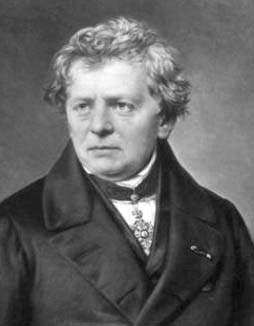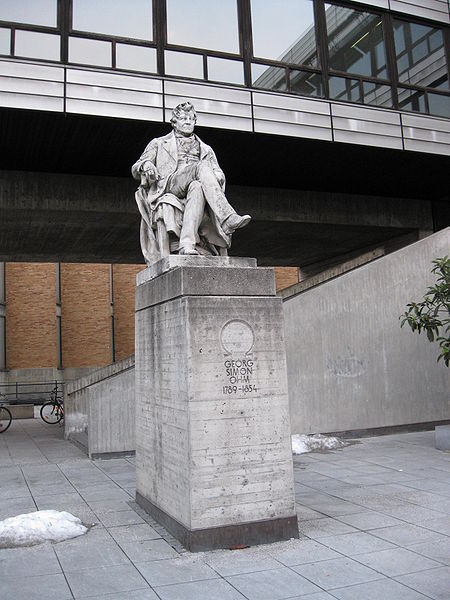<Back to Index>
- Physicist Georg Simon Ohm, 1789
- Painter Marie-Rosalie Bonheur, 1822
- Shah of Iran Reza Shah Pahlavi, 1878


Georg Simon Ohm (16
March 1789 – 6 July 1854) was a German physicist. As a high school
teacher, Ohm began his research with the recently invented electrochemical cell, invented by Italian Count Alessandro Volta. Using equipment of his own creation, Ohm determined that there is a direct proportionality between the potential difference (voltage) applied across a conductor and the resultant electric current – now known as Ohm's law. Using the results of his experiments, Ohm was able to define the fundamental relationship among voltage, current, and resistance, which represents the true beginning of electrical circuit analysis. Georg Simon Ohm was born at Erlangen, Bavaria, son to Johann Wolfgang Ohm, a locksmith and Maria Elizabeth Beck, the daughter of a tailor in Erlangen. They were a Protestant family.
Although his parents had not been formally educated, Ohm's father was a
respected man who had educated himself to a high level and was able to
give his sons an excellent education through his own teachings. Some of
Ohm's brothers and sisters died in their childhood, only three
survived. The survivors, including Georg Simon, were his younger brother Martin,
who later became a well-known mathematician, and his sister Elizabeth
Barbara. His mother died when he was ten. From early childhood, Georg
and Martin were taught by their father who brought them to a high
standard in mathematics, physics, chemistry and philosophy.
Georg Simon attended Erlangen Gymnasium from age eleven to fifteen
where he received little in the area of scientific training, which
sharply contrasted with the inspired instruction that both Georg and
Martin received from their father. His
father, concerned that his son was wasting the educational opportunity,
sent Ohm to Switzerland where, in September 1806, he took up a post as
a mathematics teacher in a school in Gottstadt bei Nydau. Karl Christian von Langsdorf left the University of Erlangen in early 1809 to take up a post in the University of Heidelberg and Ohm would have liked to have gone with him to Heidelberg to
restart his mathematical studies. Langsdorf, however, advised Ohm to
continue with his studies of mathematics on his own, advising Ohm to
read the works of Euler, Laplace and Lacroix.
Rather reluctantly Ohm took his advice but he left his teaching post in
Gottstadt bei Nydau in March 1809 to become a private tutor in Neuchâtel.
For two years he carried out his duties as a tutor while he followed
Langsdorf's advice and continued his private study of mathematics. Then
in April 1811 he returned to the University of Erlangen. His studies had stood him in good position for his receiving a doctorate from
Erlangen on 25 October 1811 and immediately joined the staff as a
mathematics lecturer. After three semesters Ohm gave up his university
post because of unpromising prospects while he couldn't make both ends
meet with the lecturing post. The Bavarian government offered him a
post as a teacher of mathematics and physics at a poor quality school in Bamberg and he took up the post there in January 1813. Feeling unhappy with his job, Georg devoted to writing an elementary book on Geometry as
a way to prove his true ability. The school was then closed down in
February 1816. The Bavarian government sent him to an overcrowded
school in Bamberg to help out with the mathematics teaching. After that, he sent the manuscript to King Wilhelm III of Prussia upon its completion. The King was satisfied with Georg's work and he offered Ohm a position at a Jesuit Gymnasium of Cologne on
11 September 1817. Thanks to the school's reputation for science
education, Ohm found himself required to teach physics as well as
mathematics. Luckily, the physics lab was well-equipped, so Ohm devoted
himself to experimenting on physics. Being the son of a locksmith,
Georg had some practical experience with mechanical equipment. He published Die galvanishe Kette, mathematisch berabeitet in 1827, which in English is The Galvanic Circuit Investigated Mathematically.
Cologne's Jesuit College did not laud his work and Ohm resigned his
professorial position there and instead applied to and was employed by
the Polytechnic school of Nuremberg (Nürnberg). He came to the polytechnic school of Nuremberg in 1833, and in 1852 became professor of experimental physics in the university of Munich, where he later died. He is buried in the Alter Südfriedhof in Munich. His writings were numerous. The most important was his pamphlet published in Berlin in 1827, with the title Die galvanische Kette mathematisch bearbeitet.
This work, the germ of which had appeared during the two preceding
years in the journals of Schweigger and Poggendorff, has exerted an
important influence on the development of the theory and applications of electric current. Although
Ohm's work strongly influenced theory, at first it was received with
little enthusiasm. However, his work was eventually recognized by the Royal Society with its award of the Copley Medal in 1841. He became a foreign member of the Royal Society in 1842, and in 1845 he became a full member of the Bavarian Academy of Sciences and Humanities.